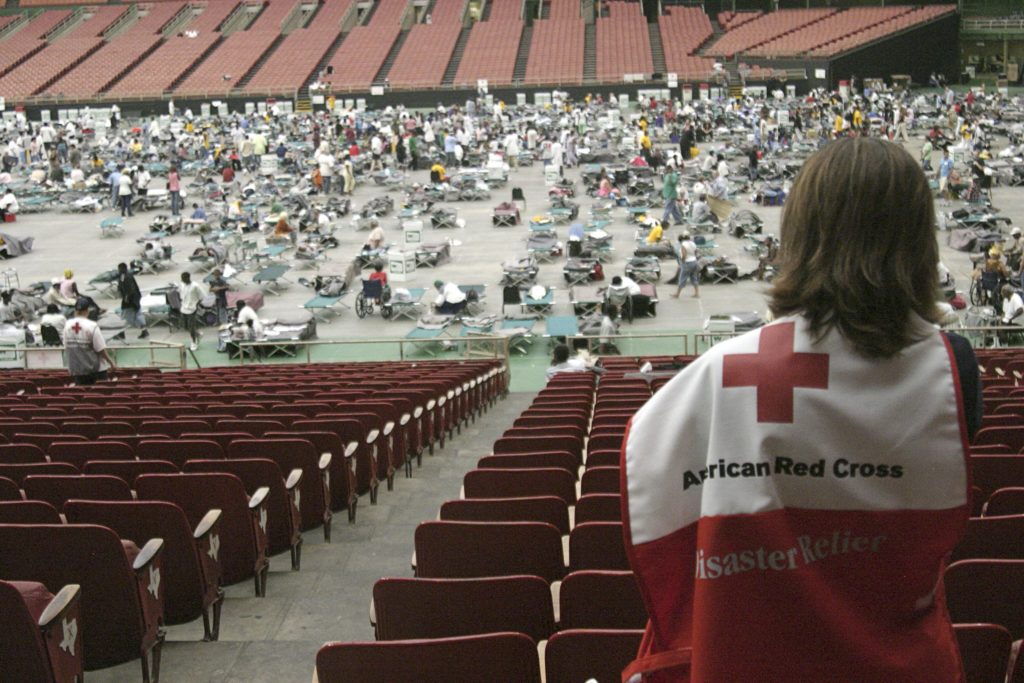Today marks the end of The Weather Channel’s Hurricane Week. To commemorate this, I have made a list of the top three worst hurricanes to hit the U.S. in the past 20 years (which also happens to be how old I am. Coincidence? I think not.) and some of the ways the American Red Cross responded.
1. Hurricane Katrina – 2005
The Category 5 Hurricane Katrina by far tops this list. In the U.S., areas up and down the eastern seaboard felt Katrina. However, Florida, Mississippi, Alabama, and especially Louisiana were hit incredibly hard. The image of the levy breaking in New Orleans is one that will stay with many of us for a long time. Hurricane Katrina was not only the costliest hurricane in U.S. history, incurring about $108 billion in damage, but it was also the fifth deadliest, claiming approximately 1,833 deaths.
In total, Hurricane Katrina damaged or destroyed approximately 30,000 homes and, consequently, more than 1 million people were in need of temporary shelter. In the 2005 hurricane season alone, the Red Cross opened nearly 1,400 evacuation shelters sheltering almost 450,000 evacuees. Additionally, more than 68 million hot meals and snacks were served to evacuees and responders.

2. Hurricane Sandy – 2012
If you were on the East Coast of the United States in October of 2012, you definitely felt at least some effects of Hurricane Sandy. New York and New Jersey residents felt the full impact of the storm, with much of Manhattan being evacuated and significant portions of the Jersey Shore being completely destroyed. While Sandy was the deadliest and most destructive hurricane of the 2012 Atlantic storm season, it was also the second costliest hurricane in U.S. history. To date, Sandy has cost about $65 billion dollars, however, the total cost is still being evaluated. Most of that cost is due to the 650,000 houses were either damaged or destroyed by Sandy.
In the wake of the devastation, the Red Cross responded to the extreme needs of residents. The Red Cross send out over 300 emergency response vehicles that aided in the distribution of over seven million relief items and 17 million meals and snacks. Additionally, there were over 81,000 overnight stays in shelters. To this day, the Red Cross is continuing to aid the victims of Hurricane Sandy get back into their homes and return to a sense of normalcy.

3. Hurricane Ike
Hurricane Ike was the Category 4 storm that made landfall in the U.S. in September of 2008. Ike caused the most damage along the Texas and Louisiana coasts. However, it was felt through the Mississippi and Ohio Valleys as well, and even impacted some parts of eastern Canada. Ike is responsible for 112 deaths in the U.S. alone, but also killed 74 Haitians. Furthermore, Ike caused a whopping $37.5 billion in damage, making it one of the costliest storms in U.S. history.
During Hurricane Ike, the Red Cross supported 241 evacuee shelters, which provided over 157,000 overnight stays. Additionally, other community-based organizations ran an additional 150 shelters, to total almost 400 shelters operating in response to Ike. On September 13, peak shelter occupancy was reached, with 32,856 people staying overnight in shelters.

While today marks the end of Hurricane Week, it also is the end of the Discovery Channel’s Shark Week. Most of us have viewed the potential dangers of combining these two potential killers in the form of SyFy’s Sharknado. I think it is safe to say that hurricanes, especially Katrina, Sandy, and Ike are devastating enough on their own. No one wants sharks to be mentioned in the same sentence as a hurricane. For the foreseeable future, it is fair to say that sharks will be staying in the water, far from residents on land. Hurricanes, however, will not.
To learn how to be prepared for the next hurricane, find tips on redcross.org.
